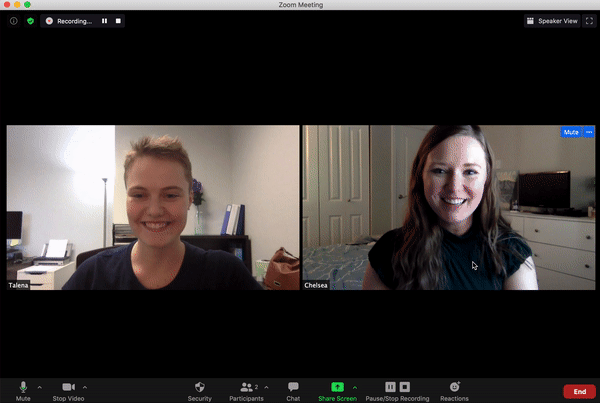-Fatigue-Cover.jpg?width=1026&name=5-Strategies-to-Combat-Video-Conferencing-(Zoom)-Fatigue-Cover.jpg)
Let’s take a little quiz.
- Are you extra tired lately?
- Do you feel like even though you’re doing less, such as skipping the tiresome commute, you have less energy?
- Have you wrestled with how to tell your grandma that you just don’t have it in you to spend another twenty minutes staring at her forehead while she looks for the unmute button?
If you answered “yes” to any of these questions, YOU’VE JUST WON A NEW CAR! (Sorry. Kidding.) The truth is that you, like most people on earth right now, are suffering from the newfound level of screen trauma known colloquially as “Zoom fatigue.”
The name, of course, doesn’t relate only to Zoom, but any video conferencing platform or just digital communications in general. And jokes aside, it is, unfortunately, a very real phenomenon that many of us are experiencing now in this accelerated age of remote communication.
Here at VMG Studios, a creative marketing and branding agency in the Seattle area, we’re constantly connecting with our clients at enterprise-level corporations via video conferencing platforms such as Zoom, Microsoft Teams, Amazon Chime, Cisco Webex, BlueJeans, the list goes on and on – and we’re tired too.
So, we decided to figure out ways to help one another with Zoom fatigue as we continue to move forward in this new digital age.
What Exactly is Zoom Fatigue?
Basically, Zoom fatigue is the mental exhaustion that comes from focusing your attention on what is an unnatural form of communication. Another way to put it, according to the top definition on Urban Dictionary, Zoom fatigue is, “Sore buttocks and slight throbbing of head from staring at everyone in their pajamas while participating in meeting after meeting in your dining room due to social distancing due to COVID-19.” Pretty straightforward.
You may be thinking, “Why are we just talking about this now? We’ve been a screen dependent society for years now.” True, but in December of 2019, the average amount of daily Zoom users was 10 million. In March of 2020, it had spiked to an average of 200 million. Per day.
One of the key negative elements of Zoom fatigue is how it increases our stress levels as we work overtime to both decode others and overact our own nonverbal communications to help others decode us. In other words, we’re spending more energy trying to figure out everyone else’s body language over video and it’s stressing us out.
And then there are the vanity measures. As outlined in a Forbes article, “Staring at yourself into a camera while knowing several other people staring at you tends to add more pressure on focusing on your appearance rather than the meeting.” It’s as if this new age of video conferencing has reverted all of us back to our insecure teenage selves. I remember as a fourteen-year-old, mortified to be existing in a public place with my parents.
%20Fatigue%20V4.gif)
My mom asked me if I had been paying attention to literally anyone else around me, which, of course, I hadn’t because I’d been too hyper-focused on myself. Bingo. It’s a ridiculous catch-22; everyone is so worried about being judged that they don’t have time to judge anyone themselves, yet here we are.
It’s Not Just the Screen Time
The issues of Zoom fatigue are related to a lot more than our increase in video chatting. It’s foolish if we don’t consider the catalyst. Why is this happening again? Why am I on Zoom calls for more hours of the day than the hours I spend sleeping?
The pandemic has caused a lot of stressful side issues, but that doesn’t take away from the fact that we are, you know, living in a pandemic.
The fact that we are video conferencing so much to the point where we’ve developed a term for it is, honestly, scary to a lot of folks.
It’s a sign that this 2020 nightmare is here for the long haul. It reminds us that it isn’t safe to go outside without a mask or go to work and shake hands with clients. It reminds us of how much we miss our friends and family in the flesh, and how much as human beings, we crave the element of touch. It reminds us how scared we are of the unknown and the uncontrollable.
Surprise, surprise, we’re stressed.
The Good News
It’s not all gloom and doom. Even though we can’t exactly just stop working from home or communicating with our bosses, friends, and family – we CAN take manageable steps to lessen the effects of Zoom fatigue and get our energy back on track.
Here’s how.
1. Practice Mindfulness
I’ve said it before, and I’ll say it again; meditate. Even if you’ve never tried it before – wait, no – especially if you’ve never tried it before. Mindfulness in general (taking some time to breathe, journaling, focusing attention on gratitude, etc.) is a fantastic way to reset your brain and can drastically improve focus and mood (which endless Zoom meetings tend to deplete.)
Try breaking up your day by taking little moments to stretch, walk around, and rest your eyes on something other than a screen. Headspace is a great tool for daily mindfulness practice. There are also a ton of free options on YouTube.
%20Fatigue%20V4-1.jpeg?width=400&name=5%20Ways%20to%20Cope%20with%20Video%20Conferencing%20(Zoom)%20Fatigue%20V4-1.jpeg)
2. Turn Off Your Camera
This one can be a little tricky because the people on the other end of the video call might assume you’re distracted or uninterested. So, it’s important to be honest with your coworkers and your friends and let them know that you’re present, but that you’re giving yourself a break by keeping your camera turned off.
Already in recurring meetings where everyone is expected to keep their camera on? Here are some tips from Forbes on talking to your boss about Zoom fatigue.
Another great option that (I think?) is pretty new (or maybe it’s old and I just now discovered it), is the “hide self view” feature on Zoom! While you’re on a call, you can click the little blue ellipses on the top right of your image, and then click on “hide self view” so you don’t see yourself in the meeting anymore. Your camera is still on so everyone else can see you, but this sort of tricks your brain into forgetting that fact and not being so focused on your appearance the whole time.

3. Create Clear Boundaries
Grandma will understand. Honestly, she’s probably longing for a good old-fashioned phone call anyway. Since we’re all going through the same thing, people are more empathetic than you might think when it comes to postponing “plans.”
And if you’re working from home, make sure you have clear boundaries set of when work starts and ends, and where it starts and ends. If at all possible, make sure you have a dedicated “office” space that you use for work and work alone, so you’re not sending mixed signals to your brain when it’s time to unwind at the end of the day.
Another trend we’ve noticed with some of our enterprise-level corporation clients is a “no meeting day.” Whether it’s a Tuesday or a Friday, we’ve seen a shift in companies telling their employees to not book any meetings on a particular day of the week to not only help combat Zoom fatigue but to also allow them to get caught up on emails or other important work.
4. Adjust Your Blue Light
You may have heard of blue light or blue light filters, but I’ve found that it’s still not widely talked about. I could probably write an entirely separate article about the negative effects that blue light has on us. To be brief, the light that emanates from our electronic devices causes a whole host of problems, from eye strain to headaches to depression.
Here’s more information on what blue light is and how it affects our eyes and our minds, and here’s a guide on how to set up your blue light filter on your PC or Mac. And if you’re really concerned about it (me), here are some relatively cheap options for blue light filter glasses (I can personally attest that they saved my eyes from strain, and have successfully prevented migraines! And no, this is not sponsored!).
5. Don’t Multitask
Especially if you are able to turn off your camera during a video conference, resist the urge to do other things. Close your eyes and listen. Minimize other tabs, turn off or mute Slack, and put your phone away.
Staying engaged with one thing at a time in this way will be like taking all of your meetings in bite-sized chunks, rather than feeling like your day was one tangled up ball of yikes.
How to Safely Keep Up With Video Conferencing
It’s safe to say that the novelty of video conferencing has worn off a bit (sorry Grandma). However, we are fortunate to live in a technological world that keeps us connected, but it can be draining, nonetheless.
Moderation is important – just like it is with some guilty pleasures such as junk food, alcohol, or trashy reality TV – when it comes to video conferencing.
If you’re feeling overwhelmed by Zoom fatigue remember these simple tricks:
- Practice mindfulness
- Turn off your camera
- Create clear boundaries
- Adjust your blue light
- Don’t multitask
Video conferencing isn’t going away. It has allowed us to keep some semblance of normal during a global pandemic. Now, it is time to check in with ourselves, our coworkers, our clients, and our friends and family to make sure we’re navigating this space in a healthy, productive manner.
Learn more about the psychology of body language and what to look out for while video conferencing by clicking the image below.



%20Fatigue%20V4.jpeg?width=267&name=5%20Ways%20to%20Cope%20with%20Video%20Conferencing%20(Zoom)%20Fatigue%20V4.jpeg)


